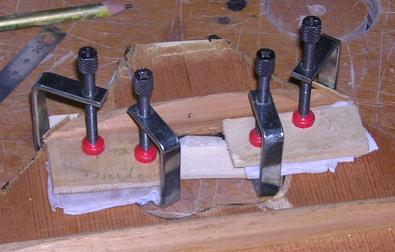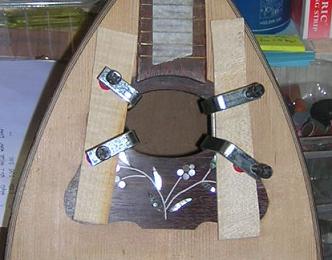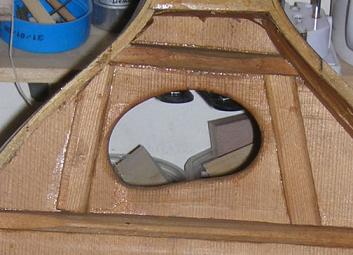| Warping of the
Table
One of the commonest and most easily visible problems with mandolins, is a warped top. The reasons for this are largely to do with string pressure, when the head and tail are pulled towards each other. The top buckles as a result, usually around the sound hole, where the hole weakens the structure of the top. |
|||
| This photo shows warping around the sound-hole caused by string pressure on the area weakened by the sound hole and inlay. | With the strings off, I use pads dipped in boiling water, against wooden cauls to try and correct the worst effects of the warping. | ||
| The pads are a small wad of folded fabric dipped in hot water them squeezed out. I sit it on a small piece of wood which goes UNDER the top at the site of the warp. The cauls on top and the small clamps, help to press the warp flat once the hot/damp pad softens the wood. After a few hours, I remove the wad, but keep the cauls to allow the softened wood to dry out better, and flat. | |||
| I then glue in a thin hole re-enforcement under the sound-hole to try and prevent further warping. This may be flat, or a small bar like a tone bar. | This picture shows a corrected warp, with the hole strengthener just visible beneath the top. | ||
| On another instrument, a mandriola, the damage was mostly to the sides of the sound hole, and again hot pads were able to reduce the distortion without removing the top. | In this photo, the hole re-enforcement is pictured before it is glued under the top. It should help the top resist the pressure of the 12 strings better. | ||
 |
On another instrument, with a detached top, it is possible to see the pads, which are folded pieces of cotton cloth placed beneath the wood. |  |
Here the re-enforcement glued in place is visible due to the detched tops. |
 |
To prevent the warping from re-occurring, I often glue re-enforcements inside. Here is one braced against cauls while the glue sets. |  |
A view of the same type of re-enforcement from inside, this time original to the instrument, in this case, a waldzither. |
 |
More recently, I have opted for this type of
brace, stronger than above right, and easier to fit, even with the top
still on than the full surround.
Braces are 2-3mm thick and 6-8mm tall. |
||